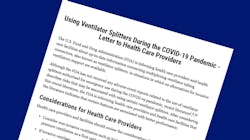FDA issues letter on using ventilator splitters during the COVID-19 pandemic
The U.S. Food and Drug Administration (FDA) issued a letter informing healthcare providers and healthcare facilities about up-to-date information concerning multiplexing ventilator tubing connectors, also known as ventilator splitters, in situations in which no alternatives for invasive ventilatory support are available.
Although the FDA has not received any adverse event reports related to the use of ventilator splitters authorized for emergency use during the COVID-19 pandemic, recent literature describes risks that may be associated with using certain ventilator splitters. After considering this recent literature, the FDA is informing healthcare providers and healthcare facilities that the literature indicates that certain features are associated with better performance.
Considerations include:
Consider non-invasive ventilation such as high flow nasal oxygen or non-invasive positive pressure ventilation as a first option prior to using an authorized ventilator splitter.
If invasive ventilation using an authorized ventilator splitter is the only option:
· Limit sharing of ventilation to two patients,
· Try to match patients based on similar ventilatory requirements,
· Limit duration of sharing ventilation to 48 hours,
· If possible, reserve at least one single patient ventilator for emergencies or to wean a patient off ventilation support
· Consider updated ventilator sharing protocols, such as the New York Presbyterian Ventilator Sharing Protocol: Dual-Patient Ventilation with a Single Mechanical Ventilator for Use during Critical Ventilator Shortages to minimize risk.
The recent literature indicates that ventilator splitters that incorporate these features may reduce certain risks:
· One-way valves in the breathing circuit,
· Flow restrictors or pressure regulators at each inspiratory limb of the circuit,
· Individual positive end-expiratory pressure (PEEP) valves,
· Inspiratory and expiratory tidal volume sensors, and
· Pressure sensors.
Ventilator splitters divide the gas flow from a single mechanical ventilator to deliver a tidal volume to more than one patient and collect expiration from these patients. On March 25, 2020, the FDA issued an Emergency Use Authorization (EUA) that authorizes the emergency use of certain ventilators and ventilator accessories for treating patients during the COVID-19 pandemic to address the observed and anticipated shortages of ventilators and ventilator accessories.
The FDA issued this EUA for ventilator splitters based in part on data from two preclinical studies that showed that ventilator splitters may be effective in providing ventilation to multiple patients from a single ventilator. In consideration of an imminent projected shortage of ventilators at that time, and based on the available information at the time, the FDA concluded that the known and potential benefits of using ventilator splitters outweighed the known and potential risks.
During the past nine months of the pandemic, clinicians have gained real-world experience with shared ventilators and additional research has been performed on the conditions for safe use. These activities greatly increased the understanding of the known and potential risks and benefits of ventilator splitters in a very short time.
Some of the challenges identified in reported clinical experience include:
· The need to continually balance differences in respiratory mechanics of both co-vented patients;
· The need for paralysis and deep sedation to prevent asynchrony;
· Swinging air from one co-vented patient to another (pendelluft), resulting in lung injury due to overdistension of the alveoli (volutrauma), or inspired carbon dioxide;
· The increased complexity of clinical decision making; and
· The lack of individual ventilator alarms to alert individual ventilation problems.
These findings highlight the importance of only using ventilator splitters in situations where there are no other alternatives for invasive ventilation, and in accordance with the recommendations outlined above.
The FDA is monitoring clinical experience with ventilator splitters during the COVID-19 pandemic and is continuing to evaluate the emergency use authorization of these devices. The FDA plans to keep healthcare providers and the public informed if significant new information becomes available.
